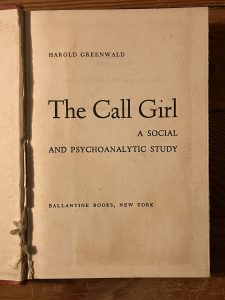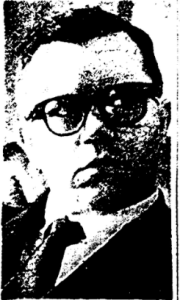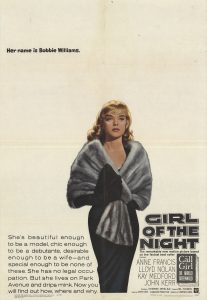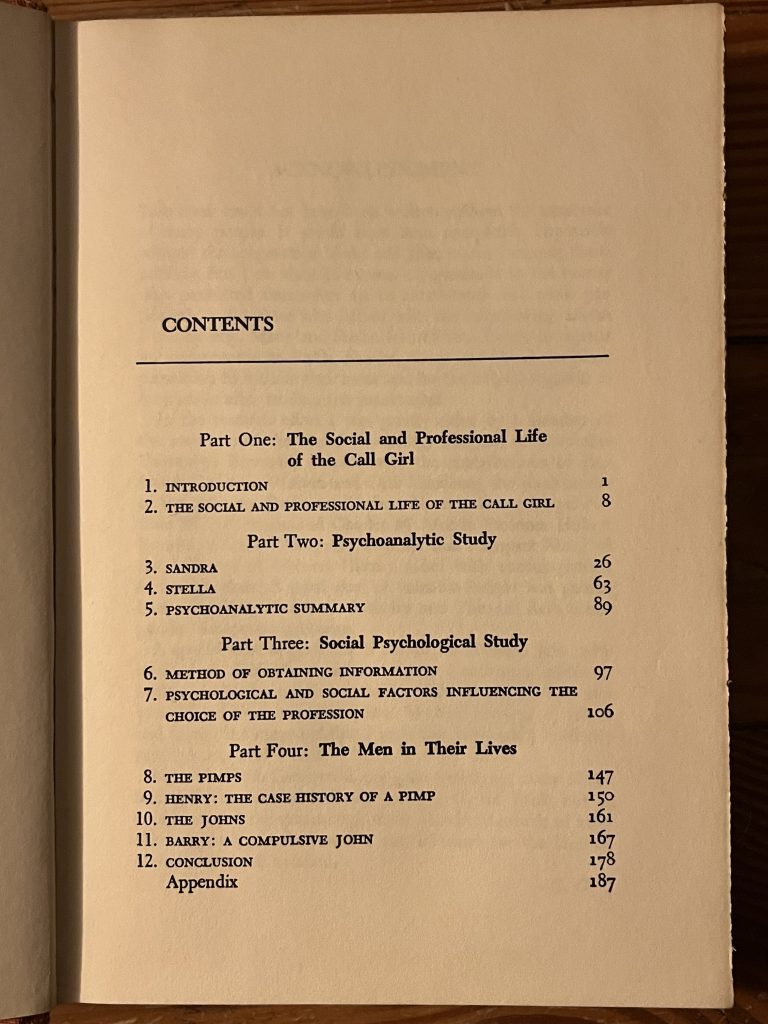
“This is a book about the call girl: her psychology, her life and the men in her life.” writes Dr. Harold Greenwald in his book Call Girl: A Social and Psychoanalytic Study, published in 1958. Greenwald further asserts that “The call girls in this book are the aristocrats of prostitution. They live in the most expensive residential sections of our large cities, they dress in rich, good taste. They charge a minimum of twenty dollars per sexual contact.” (1) Greenwald’s Call Girl: A Social and Psychoanalytic Study was a best-seller and adapted into a film in 1960.
Dr. Harold Greenwald was born in Manhatten, New York on July 28, 1910. He was the oldest of three. His career in psychoanalysis was not a direct route. Before psychology, Greenwald worked for the city housing authority and planning board after graduating in 1933 from City College. Additionally, he worked as a “remedial reading teacher, case worker for the Board of Child Welfare, group worker with cellar clubs for Youth Services.” (2) He then worked as a civilian instructor for the Army Air Forces. (3)

Dr. Harold Greenwald
At 45 or 46, Greenwald earned his Ph.D. in Social Psychology from Columbia University in 1956. Although he started his career a bit late in life, his interest in psychology started at a young age when a local librarian introduced Greenwald to psychologist, G. Stanley Hall’s work titled, Adolescence (1904). Hall received the first Ph.D. in Psychology in the United States in 1878 from Harvard University. Hall was also “instrumental in founding psychology as a science and in its development as a profession.” (4) He was the first president of the American Psychological Association and “was credited with discovering adolescence” and published his findings in the book that was suggested to Greenwald. (5) Hall described that adolescence:
…came about due to social changes at the turn of the 20th century. Because of the influence of Child Labor Laws and universal education, youth had newfound time in their teenage years when the responsibilities of adulthood were not forced upon them as quickly as in the past. Hall did not have a very positive view of this phase, and he believed that society needed to ‘burn out the vestiges of evil in their nature.’ Therefore, adolescence was a time of overcoming one’s beast-like impulses as one was englufed in a period of ‘storm and stress.’ He identified three key aspects of this phase: mood disruptions, conflict with paretns, and risky behavior. (6)
The reason for this reference by the librarian is unknown, but it is seemingly the origin of Greenwald’s interest in the profession.
Greenwald wrote several books throughout his career on psychology, sex, relationships, and sex workers. (7) His most known book was his doctorate dissertation which was published in 1958, titled Call Girl: A Social and Psychoanalytic Study. Although an academic book it was popular among the general public due to the details it entailed on the lives of sex workers that Greenwald interviewed. Greenwald’s research consisted of interviews with 16 sex workers. Greenwald interviewed 6 himself and the other 10 were interviewed by three women research assistants. His book was described as “[humanizing] the women and explained why they chose to work as prostitutes. Most, he wrote, came from unhappy childhoods and felt little love from either parent.” (8) Greenwald gave the public access to a world that many were curious of but had no connection to.
Marie: Since I think it is a business I act very careful. I have health examinations every ten days and use a strong mouth wash. I’m willing to have oral sex with a man or a woman. Occasionally some of the men want an exhibition and so I’ll do it, but I get no feelingout of it. In fact, I never get sexual satisfaction out of either man or woman. I was a virgin when I got married and I have had anything to do with any man other than my husband, With my husband, I got pleasure out of doing something that I recognized he liked but no physical sensation.
I’ve managed to keep my two lives separate. I still belong to the United Daughters of the Confederacy and to the Daughters of the American Revolution. And of course none of these people know what I do to earn a living. Two of the things which keep me going are religion are books. I don’t care what kind of church it is or even a synagogue. If I pass one and I happen to feel low, I’ll go in and I’ll pay.
For reading I belong to the Book of the Month Club. I like to read popular fiction, historical novels and plays. (9)
 Call Girl: A Social and Psychoanalytic Study was shortly adapted into a film two years later in 1960. The film is titled, Girl of the Night, and follows a sex worker named Robin “Bobbie” Williams, played by Anne Francis, who begins seeing a therapist, Dr. Mitchell, played by Lloyd Nolan. The therapy sessions commence after Williams is brought to Dr. Mitchell who works out of her apartment building following her being physically harmed by a customer. From the therapy sessions, Williams unpacks her childhood trauma and discusses her reasoning for sex work. She explains to Mitchell that she does this particular labor to help raise enough money for her and her boyfriend to get married. Due to self-discovery done in therapy, Bobbie leaves sex work and her boyfriend for a bit but is drawn back to the labor that she is accustomed to. The film ends with Bobbie again leaving her boyfriend and sex work for
Call Girl: A Social and Psychoanalytic Study was shortly adapted into a film two years later in 1960. The film is titled, Girl of the Night, and follows a sex worker named Robin “Bobbie” Williams, played by Anne Francis, who begins seeing a therapist, Dr. Mitchell, played by Lloyd Nolan. The therapy sessions commence after Williams is brought to Dr. Mitchell who works out of her apartment building following her being physically harmed by a customer. From the therapy sessions, Williams unpacks her childhood trauma and discusses her reasoning for sex work. She explains to Mitchell that she does this particular labor to help raise enough money for her and her boyfriend to get married. Due to self-discovery done in therapy, Bobbie leaves sex work and her boyfriend for a bit but is drawn back to the labor that she is accustomed to. The film ends with Bobbie again leaving her boyfriend and sex work for
Olive: One of the things I like with a man, and any man who can do this can have me any time, is I like him to take off all his clothes, get on his belly and come crawling to me like a snake; come crawling right through the kitchen, through the hall, into the living room and on into the bedroom. Any man who would do that really could get me excited. I don’t care much about hirring or being hit. But this really gets me.
I don’t mind girls either. In fact I like them sometimes. It’s nice to have a change. I don’t care, though, for girls who try to boss you around. I like them to be soft and pleasant.
One day while I was still going with Joe and giving him half of my money and more, I decided that this was too much. By this time I knew plenty of men who would call me up on their own and I really didn’t need him any more. Besides it wasn’t so good with him. His wife was always calling up and making a fuss and a bother. I didn’t feel like taking him away from her any more so I just moved into another place and never saw him again. Two weeks ago I heard that he found out where I was living and was going to make trouble, so I came to New York.
I just got to New York last week. I haven’t really gotten located yet. I have a lot of friends, thought, who I know from Chicago, a lot of New York men who used to come see me there, and I think I’m going to like New York okay. (10)
Overall, Dr. Harold Greenwald’s book, Call Girl: A Social and Psychoanalytic Study, was a groundbreaking study of sex workers at the time. Greenwald and his research assistants made space for the men and women to open up about their experiences in the field. The shared stories gave the public an insight into a type of labor that is largely ostracized. Although Greenwald’s work was groundbreaking, it tends to place some women into the “seduced and fallen” idea of the 19th century, particularly in how Bobbie is represented in the film adaptation. Though this may be the reason some workers started their careers, this was not the case for all.

Sources:
(1) $20 in 1958 is $217.85 in 2024. Greenwald, Harold, Call Girl, (New York: Ballentine Books, 1958), p. 1
(2) Ibid., p.246
(3) Nick Ravo “Harold Greenwald, 88, Expert on Psychology of Prostitutes,” The New York Times.
(4) Parry, Manon. “G. Stanley Hall: psychologist and early gerontologist.” American journal of public health vol. 96,7 (2006): 1161. doi:10.2105/AJPH.2006.090647
(5) “Boston Youth Arts Evaluation Project,” Mass Cultural Council, massculturalcouncil.org
(6) Ibid.
(7) Greenwald’s other books are: Great Cases in Psychoanalysis (1969), Emotional Maturity in Love and Marriage with Lucy Freeman (1961), The Sex-Life Letter with Ruth Greenwald (1972), Active Psychotherapy (1974), Direct Decision Therapy (1974), and The Happy Person (1984); Nick Ravo “Harold Greenwald, 88, Expert on Psychology of Prostitutes,” The New York Times.
(8) Ibid.
(9) Greenwald, Harold, Call Girl, (New York: Ballentine Books, 1958), p. 215
(10) Greenwald, Harold, Call Girl, (New York: Ballentine Books, 1958), p. 222-223


Leave a Reply